PM304 - Information Systems: Business Report on John Lewis Store.
VerifiedAdded on 2023/06/15
|17
|4076
|458
Report
AI Summary
This business report provides a contextual analysis of John Lewis Department Store, focusing on its evolution and improvements over time. It highlights the company's emphasis on enhancing operations and delivering exceptional after-sales service to foster customer loyalty. The report outlines John Lewis's strategic goals, including equal ownership, profit sharing, brand recognition, better job opportunities, and financial sustainability. It examines the utilization of information systems for managing customer data, order processes, e-commerce information, and point-of-sale (PoS) data. The analysis covers the strengths of these systems in facilitating decision-making, such as improved data access, enhanced data collection, and accurate data interpretation. Additionally, the report identifies weaknesses and vulnerabilities within the systems, as well as the people and processes involved. The report concludes with recommendations for improvement and a personal reflection on the findings. The website Desklib provides past papers and solved assignments for students.
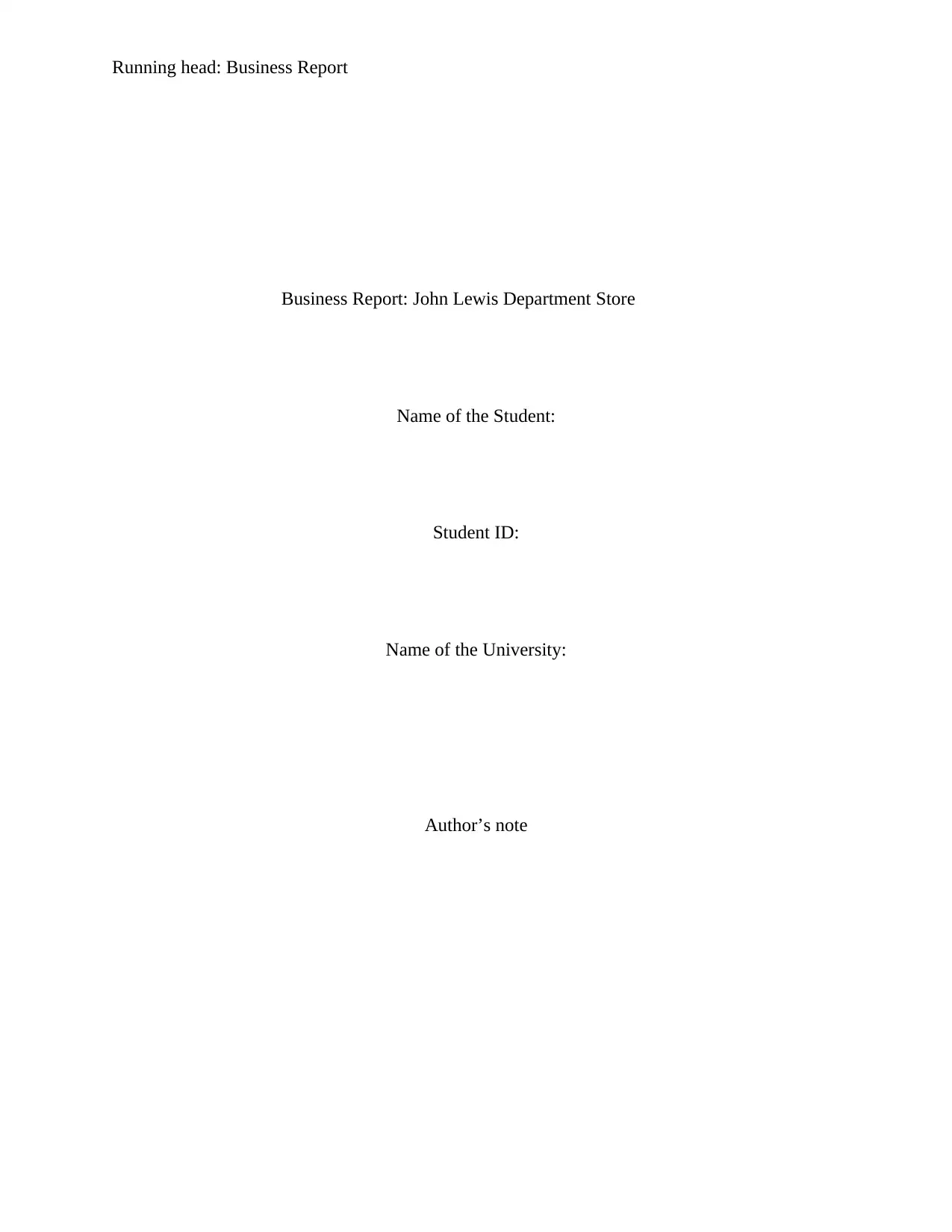
Running head: Business Report
Business Report: John Lewis Department Store
Name of the Student:
Student ID:
Name of the University:
Author’s note
Business Report: John Lewis Department Store
Name of the Student:
Student ID:
Name of the University:
Author’s note
Paraphrase This Document
Need a fresh take? Get an instant paraphrase of this document with our AI Paraphraser
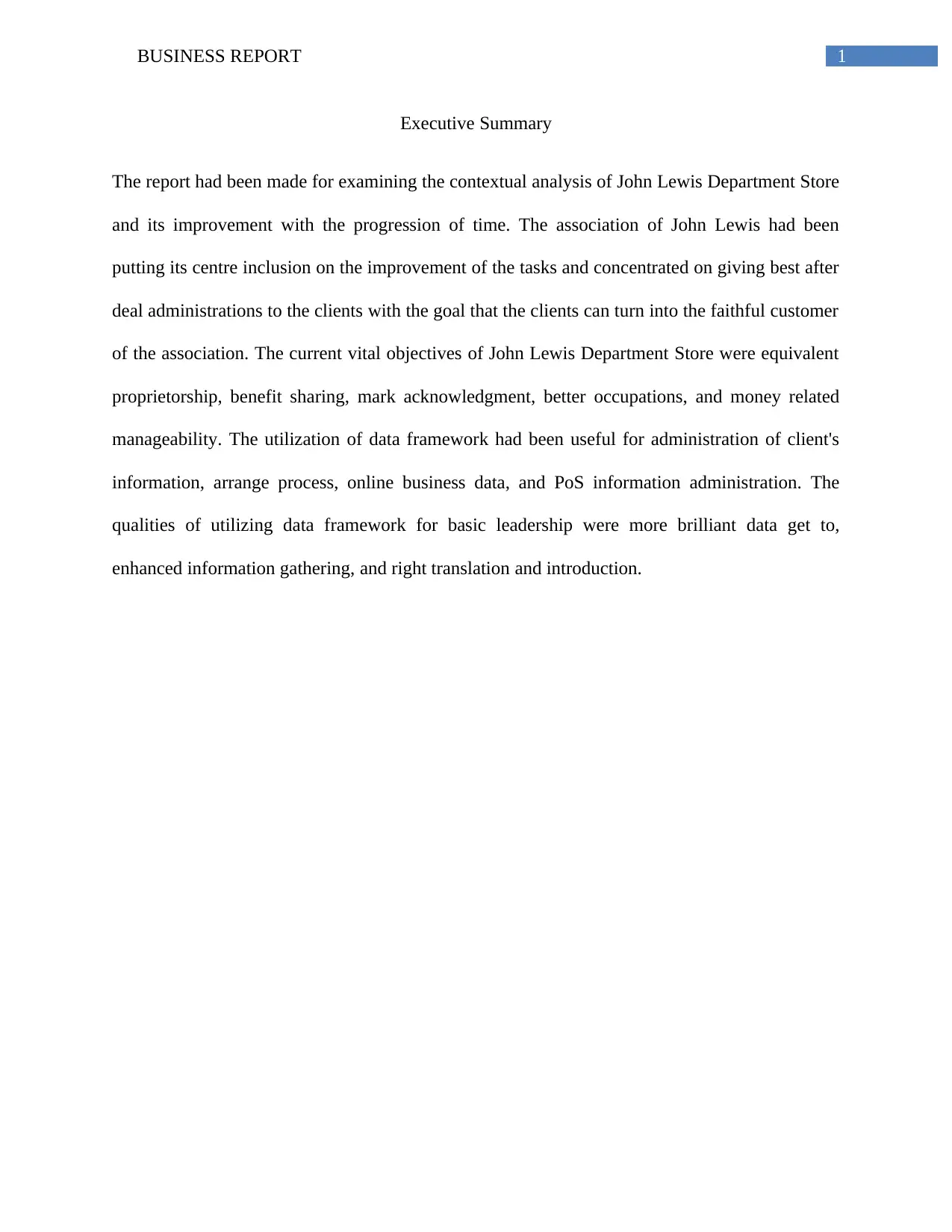
1BUSINESS REPORT
Executive Summary
The report had been made for examining the contextual analysis of John Lewis Department Store
and its improvement with the progression of time. The association of John Lewis had been
putting its centre inclusion on the improvement of the tasks and concentrated on giving best after
deal administrations to the clients with the goal that the clients can turn into the faithful customer
of the association. The current vital objectives of John Lewis Department Store were equivalent
proprietorship, benefit sharing, mark acknowledgment, better occupations, and money related
manageability. The utilization of data framework had been useful for administration of client's
information, arrange process, online business data, and PoS information administration. The
qualities of utilizing data framework for basic leadership were more brilliant data get to,
enhanced information gathering, and right translation and introduction.
Executive Summary
The report had been made for examining the contextual analysis of John Lewis Department Store
and its improvement with the progression of time. The association of John Lewis had been
putting its centre inclusion on the improvement of the tasks and concentrated on giving best after
deal administrations to the clients with the goal that the clients can turn into the faithful customer
of the association. The current vital objectives of John Lewis Department Store were equivalent
proprietorship, benefit sharing, mark acknowledgment, better occupations, and money related
manageability. The utilization of data framework had been useful for administration of client's
information, arrange process, online business data, and PoS information administration. The
qualities of utilizing data framework for basic leadership were more brilliant data get to,
enhanced information gathering, and right translation and introduction.
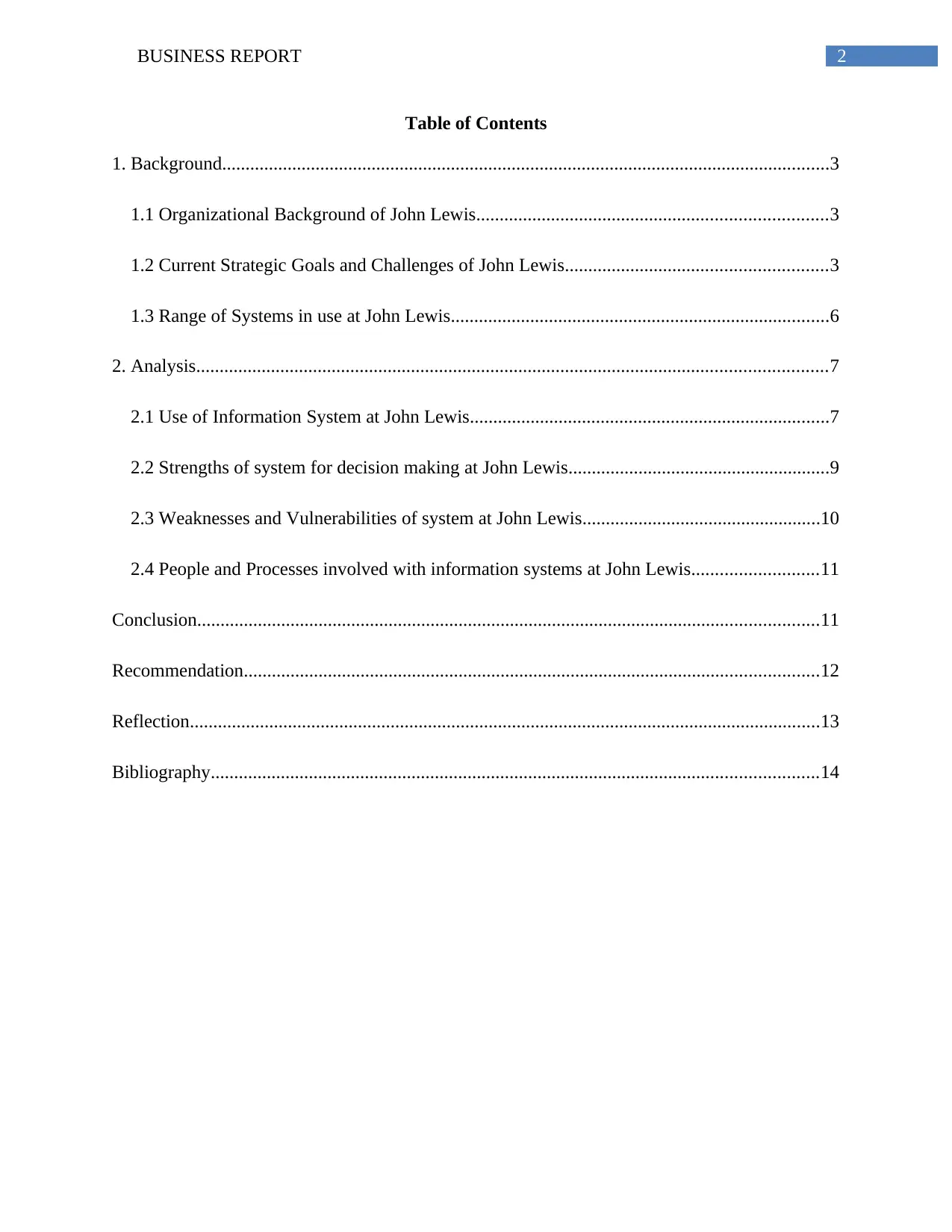
2BUSINESS REPORT
Table of Contents
1. Background..................................................................................................................................3
1.1 Organizational Background of John Lewis...........................................................................3
1.2 Current Strategic Goals and Challenges of John Lewis........................................................3
1.3 Range of Systems in use at John Lewis.................................................................................6
2. Analysis.......................................................................................................................................7
2.1 Use of Information System at John Lewis.............................................................................7
2.2 Strengths of system for decision making at John Lewis........................................................9
2.3 Weaknesses and Vulnerabilities of system at John Lewis...................................................10
2.4 People and Processes involved with information systems at John Lewis...........................11
Conclusion.....................................................................................................................................11
Recommendation...........................................................................................................................12
Reflection.......................................................................................................................................13
Bibliography..................................................................................................................................14
Table of Contents
1. Background..................................................................................................................................3
1.1 Organizational Background of John Lewis...........................................................................3
1.2 Current Strategic Goals and Challenges of John Lewis........................................................3
1.3 Range of Systems in use at John Lewis.................................................................................6
2. Analysis.......................................................................................................................................7
2.1 Use of Information System at John Lewis.............................................................................7
2.2 Strengths of system for decision making at John Lewis........................................................9
2.3 Weaknesses and Vulnerabilities of system at John Lewis...................................................10
2.4 People and Processes involved with information systems at John Lewis...........................11
Conclusion.....................................................................................................................................11
Recommendation...........................................................................................................................12
Reflection.......................................................................................................................................13
Bibliography..................................................................................................................................14
⊘ This is a preview!⊘
Do you want full access?
Subscribe today to unlock all pages.

Trusted by 1+ million students worldwide
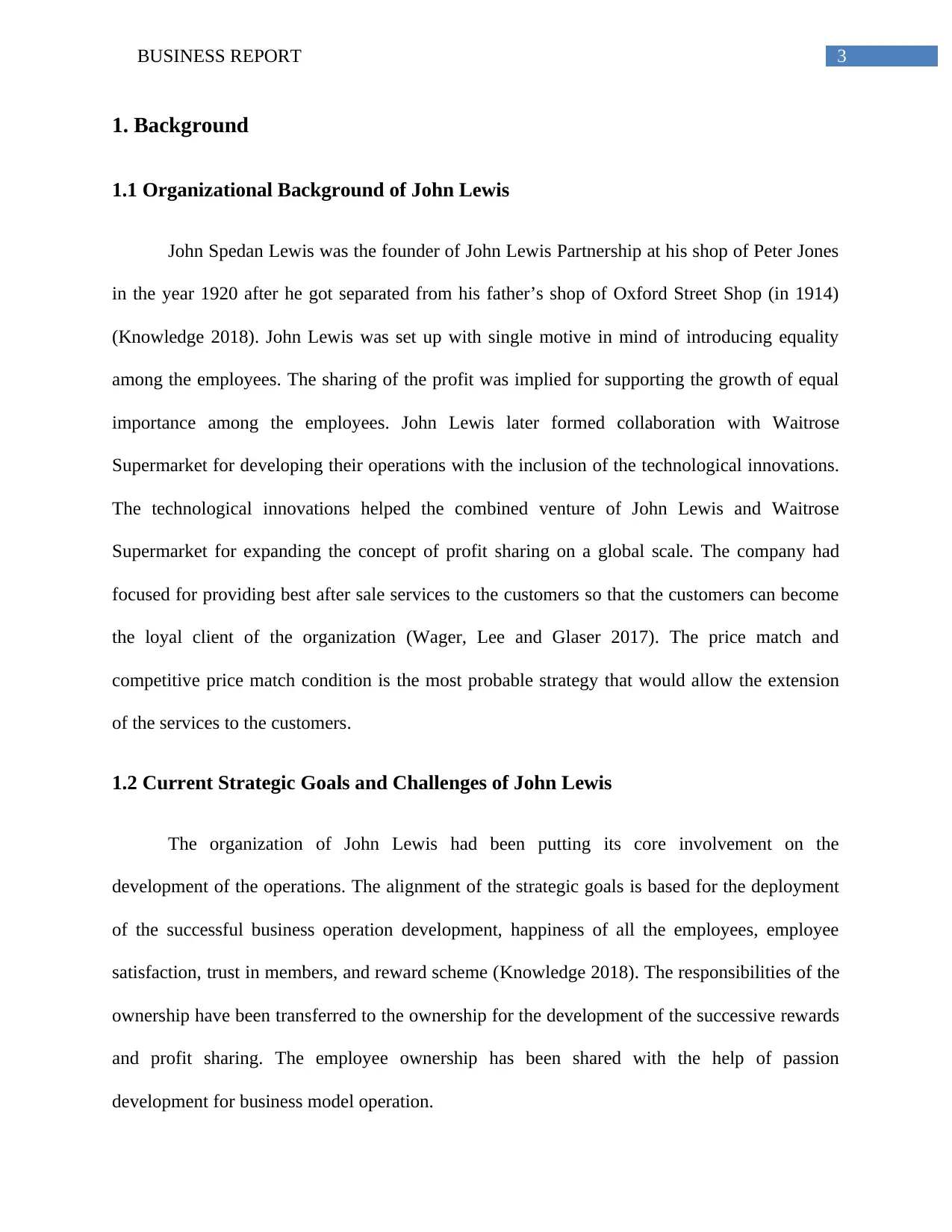
3BUSINESS REPORT
1. Background
1.1 Organizational Background of John Lewis
John Spedan Lewis was the founder of John Lewis Partnership at his shop of Peter Jones
in the year 1920 after he got separated from his father’s shop of Oxford Street Shop (in 1914)
(Knowledge 2018). John Lewis was set up with single motive in mind of introducing equality
among the employees. The sharing of the profit was implied for supporting the growth of equal
importance among the employees. John Lewis later formed collaboration with Waitrose
Supermarket for developing their operations with the inclusion of the technological innovations.
The technological innovations helped the combined venture of John Lewis and Waitrose
Supermarket for expanding the concept of profit sharing on a global scale. The company had
focused for providing best after sale services to the customers so that the customers can become
the loyal client of the organization (Wager, Lee and Glaser 2017). The price match and
competitive price match condition is the most probable strategy that would allow the extension
of the services to the customers.
1.2 Current Strategic Goals and Challenges of John Lewis
The organization of John Lewis had been putting its core involvement on the
development of the operations. The alignment of the strategic goals is based for the deployment
of the successful business operation development, happiness of all the employees, employee
satisfaction, trust in members, and reward scheme (Knowledge 2018). The responsibilities of the
ownership have been transferred to the ownership for the development of the successive rewards
and profit sharing. The employee ownership has been shared with the help of passion
development for business model operation.
1. Background
1.1 Organizational Background of John Lewis
John Spedan Lewis was the founder of John Lewis Partnership at his shop of Peter Jones
in the year 1920 after he got separated from his father’s shop of Oxford Street Shop (in 1914)
(Knowledge 2018). John Lewis was set up with single motive in mind of introducing equality
among the employees. The sharing of the profit was implied for supporting the growth of equal
importance among the employees. John Lewis later formed collaboration with Waitrose
Supermarket for developing their operations with the inclusion of the technological innovations.
The technological innovations helped the combined venture of John Lewis and Waitrose
Supermarket for expanding the concept of profit sharing on a global scale. The company had
focused for providing best after sale services to the customers so that the customers can become
the loyal client of the organization (Wager, Lee and Glaser 2017). The price match and
competitive price match condition is the most probable strategy that would allow the extension
of the services to the customers.
1.2 Current Strategic Goals and Challenges of John Lewis
The organization of John Lewis had been putting its core involvement on the
development of the operations. The alignment of the strategic goals is based for the deployment
of the successful business operation development, happiness of all the employees, employee
satisfaction, trust in members, and reward scheme (Knowledge 2018). The responsibilities of the
ownership have been transferred to the ownership for the development of the successive rewards
and profit sharing. The employee ownership has been shared with the help of passion
development for business model operation.
Paraphrase This Document
Need a fresh take? Get an instant paraphrase of this document with our AI Paraphraser
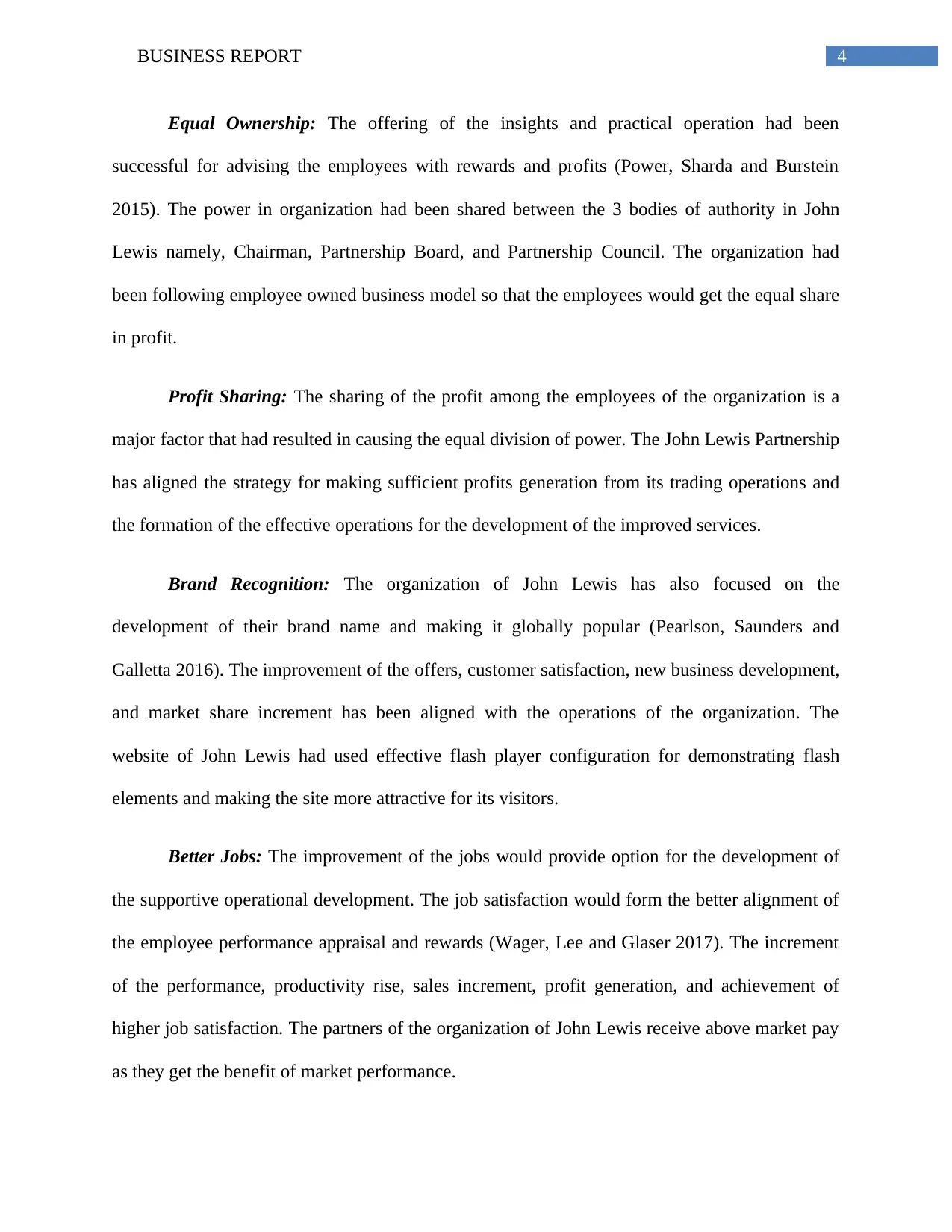
4BUSINESS REPORT
Equal Ownership: The offering of the insights and practical operation had been
successful for advising the employees with rewards and profits (Power, Sharda and Burstein
2015). The power in organization had been shared between the 3 bodies of authority in John
Lewis namely, Chairman, Partnership Board, and Partnership Council. The organization had
been following employee owned business model so that the employees would get the equal share
in profit.
Profit Sharing: The sharing of the profit among the employees of the organization is a
major factor that had resulted in causing the equal division of power. The John Lewis Partnership
has aligned the strategy for making sufficient profits generation from its trading operations and
the formation of the effective operations for the development of the improved services.
Brand Recognition: The organization of John Lewis has also focused on the
development of their brand name and making it globally popular (Pearlson, Saunders and
Galletta 2016). The improvement of the offers, customer satisfaction, new business development,
and market share increment has been aligned with the operations of the organization. The
website of John Lewis had used effective flash player configuration for demonstrating flash
elements and making the site more attractive for its visitors.
Better Jobs: The improvement of the jobs would provide option for the development of
the supportive operational development. The job satisfaction would form the better alignment of
the employee performance appraisal and rewards (Wager, Lee and Glaser 2017). The increment
of the performance, productivity rise, sales increment, profit generation, and achievement of
higher job satisfaction. The partners of the organization of John Lewis receive above market pay
as they get the benefit of market performance.
Equal Ownership: The offering of the insights and practical operation had been
successful for advising the employees with rewards and profits (Power, Sharda and Burstein
2015). The power in organization had been shared between the 3 bodies of authority in John
Lewis namely, Chairman, Partnership Board, and Partnership Council. The organization had
been following employee owned business model so that the employees would get the equal share
in profit.
Profit Sharing: The sharing of the profit among the employees of the organization is a
major factor that had resulted in causing the equal division of power. The John Lewis Partnership
has aligned the strategy for making sufficient profits generation from its trading operations and
the formation of the effective operations for the development of the improved services.
Brand Recognition: The organization of John Lewis has also focused on the
development of their brand name and making it globally popular (Pearlson, Saunders and
Galletta 2016). The improvement of the offers, customer satisfaction, new business development,
and market share increment has been aligned with the operations of the organization. The
website of John Lewis had used effective flash player configuration for demonstrating flash
elements and making the site more attractive for its visitors.
Better Jobs: The improvement of the jobs would provide option for the development of
the supportive operational development. The job satisfaction would form the better alignment of
the employee performance appraisal and rewards (Wager, Lee and Glaser 2017). The increment
of the performance, productivity rise, sales increment, profit generation, and achievement of
higher job satisfaction. The partners of the organization of John Lewis receive above market pay
as they get the benefit of market performance.
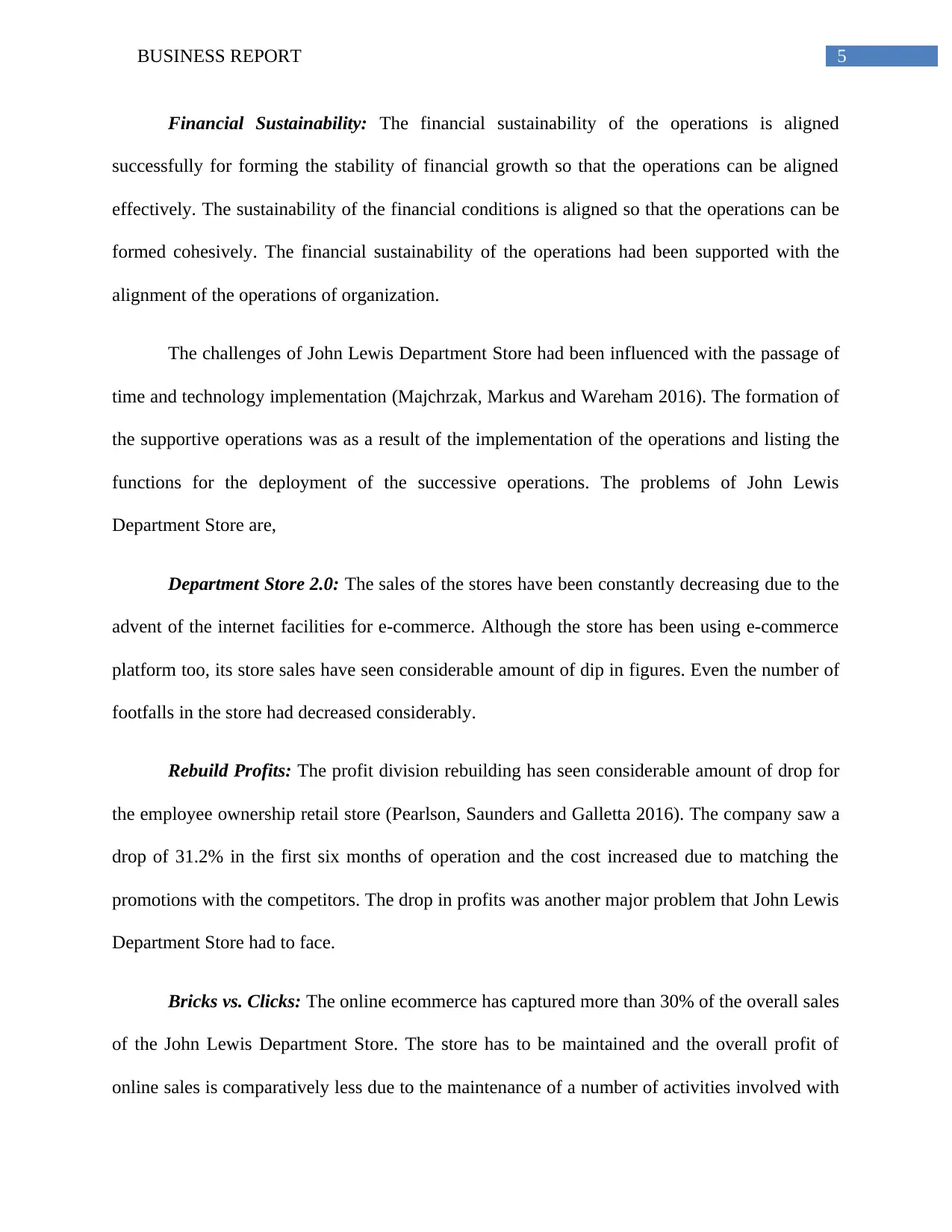
5BUSINESS REPORT
Financial Sustainability: The financial sustainability of the operations is aligned
successfully for forming the stability of financial growth so that the operations can be aligned
effectively. The sustainability of the financial conditions is aligned so that the operations can be
formed cohesively. The financial sustainability of the operations had been supported with the
alignment of the operations of organization.
The challenges of John Lewis Department Store had been influenced with the passage of
time and technology implementation (Majchrzak, Markus and Wareham 2016). The formation of
the supportive operations was as a result of the implementation of the operations and listing the
functions for the deployment of the successive operations. The problems of John Lewis
Department Store are,
Department Store 2.0: The sales of the stores have been constantly decreasing due to the
advent of the internet facilities for e-commerce. Although the store has been using e-commerce
platform too, its store sales have seen considerable amount of dip in figures. Even the number of
footfalls in the store had decreased considerably.
Rebuild Profits: The profit division rebuilding has seen considerable amount of drop for
the employee ownership retail store (Pearlson, Saunders and Galletta 2016). The company saw a
drop of 31.2% in the first six months of operation and the cost increased due to matching the
promotions with the competitors. The drop in profits was another major problem that John Lewis
Department Store had to face.
Bricks vs. Clicks: The online ecommerce has captured more than 30% of the overall sales
of the John Lewis Department Store. The store has to be maintained and the overall profit of
online sales is comparatively less due to the maintenance of a number of activities involved with
Financial Sustainability: The financial sustainability of the operations is aligned
successfully for forming the stability of financial growth so that the operations can be aligned
effectively. The sustainability of the financial conditions is aligned so that the operations can be
formed cohesively. The financial sustainability of the operations had been supported with the
alignment of the operations of organization.
The challenges of John Lewis Department Store had been influenced with the passage of
time and technology implementation (Majchrzak, Markus and Wareham 2016). The formation of
the supportive operations was as a result of the implementation of the operations and listing the
functions for the deployment of the successive operations. The problems of John Lewis
Department Store are,
Department Store 2.0: The sales of the stores have been constantly decreasing due to the
advent of the internet facilities for e-commerce. Although the store has been using e-commerce
platform too, its store sales have seen considerable amount of dip in figures. Even the number of
footfalls in the store had decreased considerably.
Rebuild Profits: The profit division rebuilding has seen considerable amount of drop for
the employee ownership retail store (Pearlson, Saunders and Galletta 2016). The company saw a
drop of 31.2% in the first six months of operation and the cost increased due to matching the
promotions with the competitors. The drop in profits was another major problem that John Lewis
Department Store had to face.
Bricks vs. Clicks: The online ecommerce has captured more than 30% of the overall sales
of the John Lewis Department Store. The store has to be maintained and the overall profit of
online sales is comparatively less due to the maintenance of a number of activities involved with
⊘ This is a preview!⊘
Do you want full access?
Subscribe today to unlock all pages.

Trusted by 1+ million students worldwide
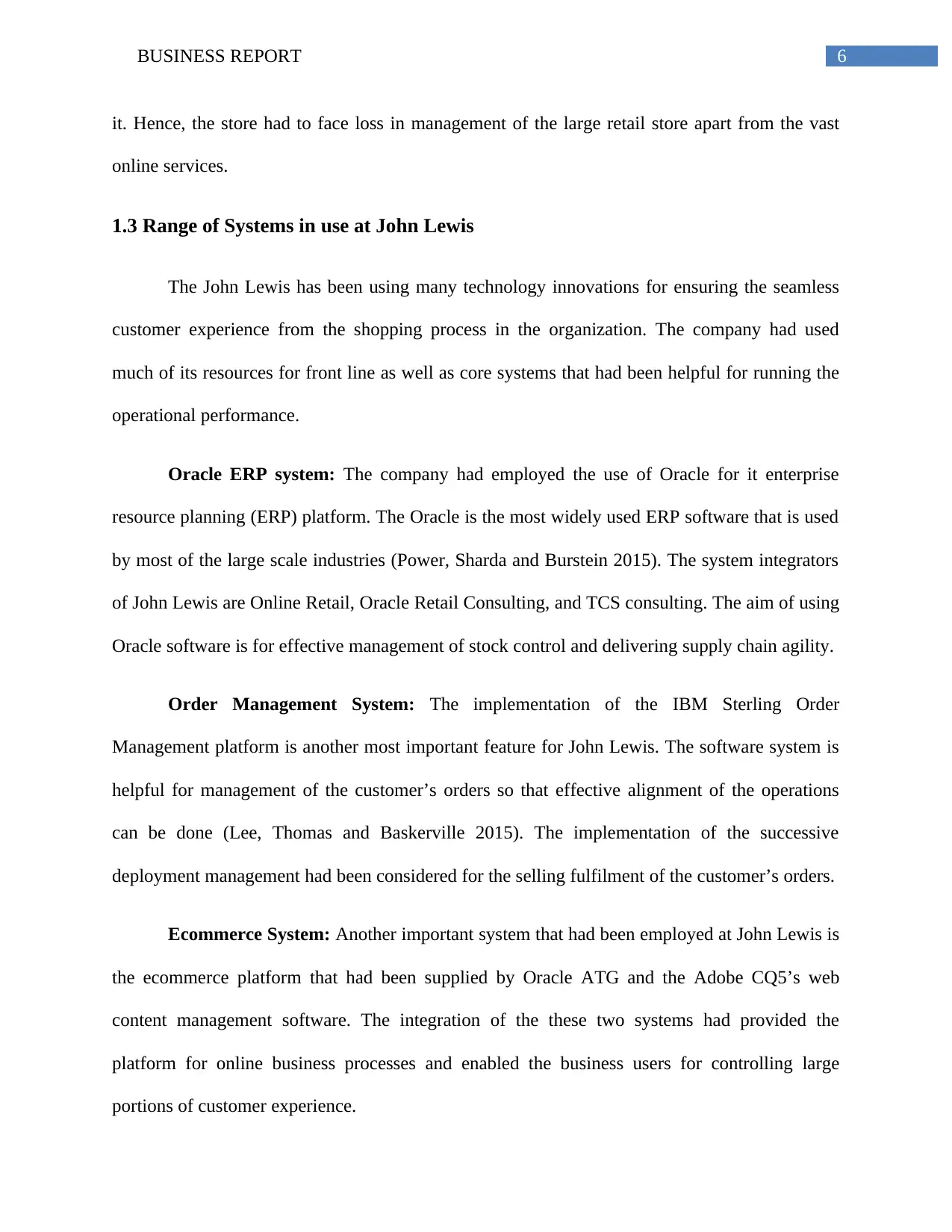
6BUSINESS REPORT
it. Hence, the store had to face loss in management of the large retail store apart from the vast
online services.
1.3 Range of Systems in use at John Lewis
The John Lewis has been using many technology innovations for ensuring the seamless
customer experience from the shopping process in the organization. The company had used
much of its resources for front line as well as core systems that had been helpful for running the
operational performance.
Oracle ERP system: The company had employed the use of Oracle for it enterprise
resource planning (ERP) platform. The Oracle is the most widely used ERP software that is used
by most of the large scale industries (Power, Sharda and Burstein 2015). The system integrators
of John Lewis are Online Retail, Oracle Retail Consulting, and TCS consulting. The aim of using
Oracle software is for effective management of stock control and delivering supply chain agility.
Order Management System: The implementation of the IBM Sterling Order
Management platform is another most important feature for John Lewis. The software system is
helpful for management of the customer’s orders so that effective alignment of the operations
can be done (Lee, Thomas and Baskerville 2015). The implementation of the successive
deployment management had been considered for the selling fulfilment of the customer’s orders.
Ecommerce System: Another important system that had been employed at John Lewis is
the ecommerce platform that had been supplied by Oracle ATG and the Adobe CQ5’s web
content management software. The integration of the these two systems had provided the
platform for online business processes and enabled the business users for controlling large
portions of customer experience.
it. Hence, the store had to face loss in management of the large retail store apart from the vast
online services.
1.3 Range of Systems in use at John Lewis
The John Lewis has been using many technology innovations for ensuring the seamless
customer experience from the shopping process in the organization. The company had used
much of its resources for front line as well as core systems that had been helpful for running the
operational performance.
Oracle ERP system: The company had employed the use of Oracle for it enterprise
resource planning (ERP) platform. The Oracle is the most widely used ERP software that is used
by most of the large scale industries (Power, Sharda and Burstein 2015). The system integrators
of John Lewis are Online Retail, Oracle Retail Consulting, and TCS consulting. The aim of using
Oracle software is for effective management of stock control and delivering supply chain agility.
Order Management System: The implementation of the IBM Sterling Order
Management platform is another most important feature for John Lewis. The software system is
helpful for management of the customer’s orders so that effective alignment of the operations
can be done (Lee, Thomas and Baskerville 2015). The implementation of the successive
deployment management had been considered for the selling fulfilment of the customer’s orders.
Ecommerce System: Another important system that had been employed at John Lewis is
the ecommerce platform that had been supplied by Oracle ATG and the Adobe CQ5’s web
content management software. The integration of the these two systems had provided the
platform for online business processes and enabled the business users for controlling large
portions of customer experience.
Paraphrase This Document
Need a fresh take? Get an instant paraphrase of this document with our AI Paraphraser
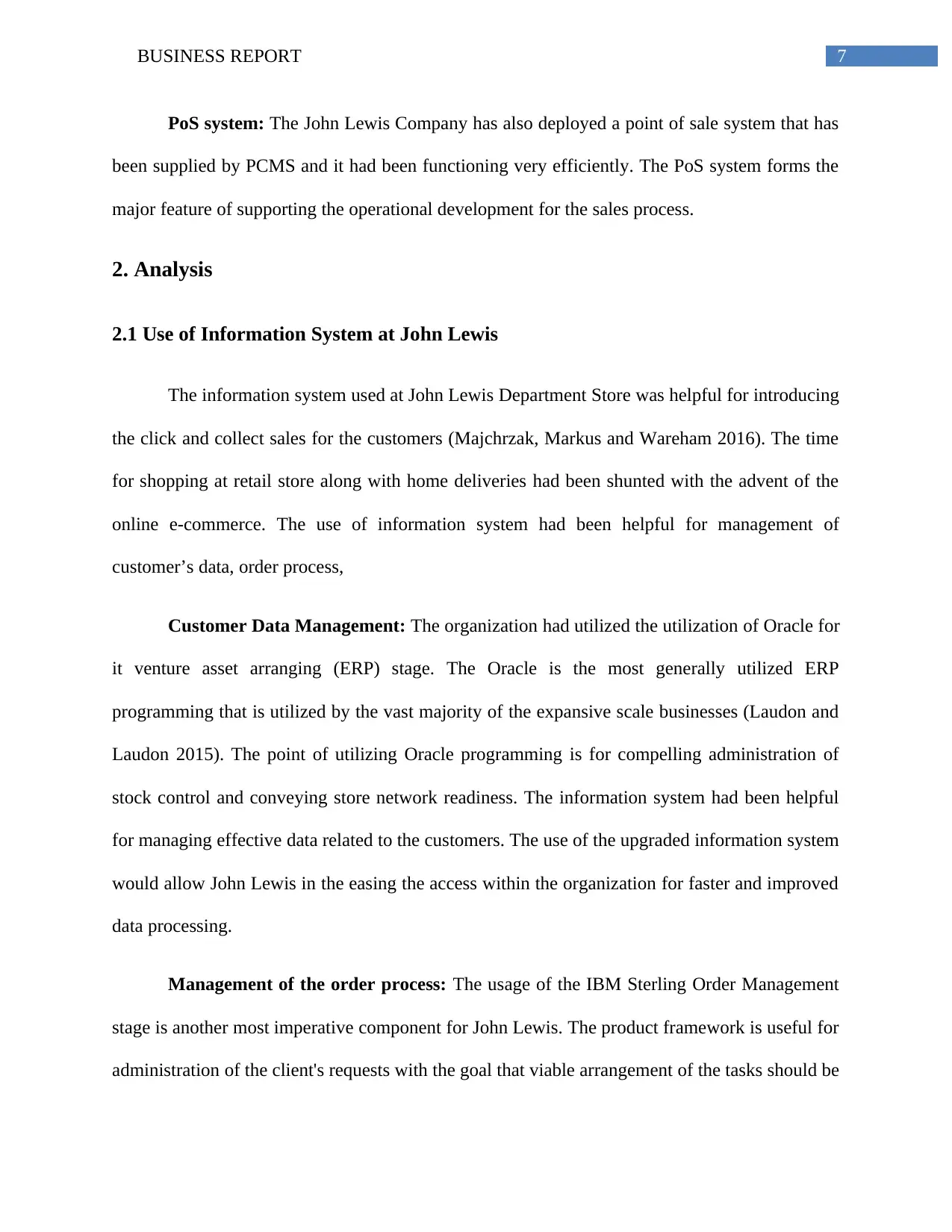
7BUSINESS REPORT
PoS system: The John Lewis Company has also deployed a point of sale system that has
been supplied by PCMS and it had been functioning very efficiently. The PoS system forms the
major feature of supporting the operational development for the sales process.
2. Analysis
2.1 Use of Information System at John Lewis
The information system used at John Lewis Department Store was helpful for introducing
the click and collect sales for the customers (Majchrzak, Markus and Wareham 2016). The time
for shopping at retail store along with home deliveries had been shunted with the advent of the
online e-commerce. The use of information system had been helpful for management of
customer’s data, order process,
Customer Data Management: The organization had utilized the utilization of Oracle for
it venture asset arranging (ERP) stage. The Oracle is the most generally utilized ERP
programming that is utilized by the vast majority of the expansive scale businesses (Laudon and
Laudon 2015). The point of utilizing Oracle programming is for compelling administration of
stock control and conveying store network readiness. The information system had been helpful
for managing effective data related to the customers. The use of the upgraded information system
would allow John Lewis in the easing the access within the organization for faster and improved
data processing.
Management of the order process: The usage of the IBM Sterling Order Management
stage is another most imperative component for John Lewis. The product framework is useful for
administration of the client's requests with the goal that viable arrangement of the tasks should be
PoS system: The John Lewis Company has also deployed a point of sale system that has
been supplied by PCMS and it had been functioning very efficiently. The PoS system forms the
major feature of supporting the operational development for the sales process.
2. Analysis
2.1 Use of Information System at John Lewis
The information system used at John Lewis Department Store was helpful for introducing
the click and collect sales for the customers (Majchrzak, Markus and Wareham 2016). The time
for shopping at retail store along with home deliveries had been shunted with the advent of the
online e-commerce. The use of information system had been helpful for management of
customer’s data, order process,
Customer Data Management: The organization had utilized the utilization of Oracle for
it venture asset arranging (ERP) stage. The Oracle is the most generally utilized ERP
programming that is utilized by the vast majority of the expansive scale businesses (Laudon and
Laudon 2015). The point of utilizing Oracle programming is for compelling administration of
stock control and conveying store network readiness. The information system had been helpful
for managing effective data related to the customers. The use of the upgraded information system
would allow John Lewis in the easing the access within the organization for faster and improved
data processing.
Management of the order process: The usage of the IBM Sterling Order Management
stage is another most imperative component for John Lewis. The product framework is useful for
administration of the client's requests with the goal that viable arrangement of the tasks should be
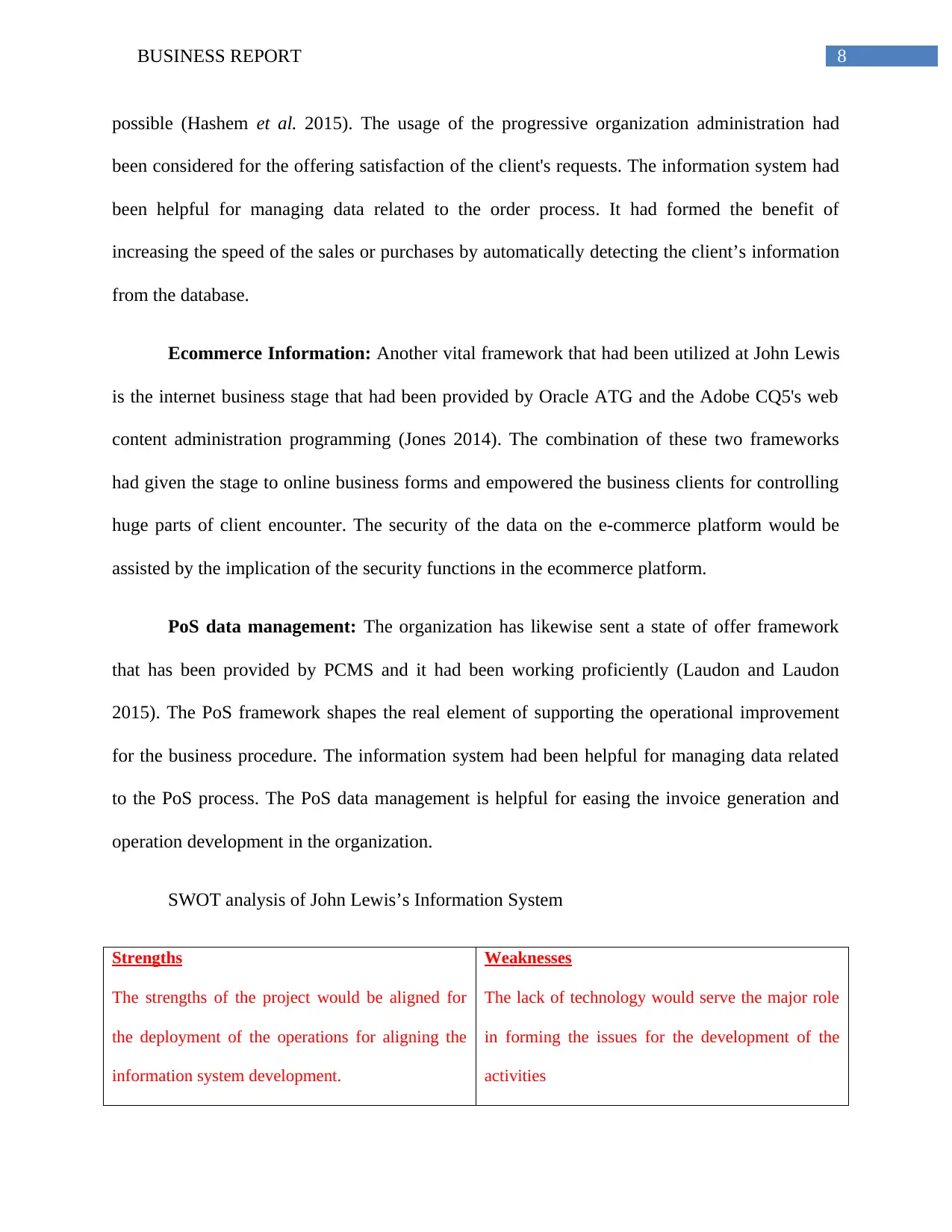
8BUSINESS REPORT
possible (Hashem et al. 2015). The usage of the progressive organization administration had
been considered for the offering satisfaction of the client's requests. The information system had
been helpful for managing data related to the order process. It had formed the benefit of
increasing the speed of the sales or purchases by automatically detecting the client’s information
from the database.
Ecommerce Information: Another vital framework that had been utilized at John Lewis
is the internet business stage that had been provided by Oracle ATG and the Adobe CQ5's web
content administration programming (Jones 2014). The combination of these two frameworks
had given the stage to online business forms and empowered the business clients for controlling
huge parts of client encounter. The security of the data on the e-commerce platform would be
assisted by the implication of the security functions in the ecommerce platform.
PoS data management: The organization has likewise sent a state of offer framework
that has been provided by PCMS and it had been working proficiently (Laudon and Laudon
2015). The PoS framework shapes the real element of supporting the operational improvement
for the business procedure. The information system had been helpful for managing data related
to the PoS process. The PoS data management is helpful for easing the invoice generation and
operation development in the organization.
SWOT analysis of John Lewis’s Information System
Strengths
The strengths of the project would be aligned for
the deployment of the operations for aligning the
information system development.
Weaknesses
The lack of technology would serve the major role
in forming the issues for the development of the
activities
possible (Hashem et al. 2015). The usage of the progressive organization administration had
been considered for the offering satisfaction of the client's requests. The information system had
been helpful for managing data related to the order process. It had formed the benefit of
increasing the speed of the sales or purchases by automatically detecting the client’s information
from the database.
Ecommerce Information: Another vital framework that had been utilized at John Lewis
is the internet business stage that had been provided by Oracle ATG and the Adobe CQ5's web
content administration programming (Jones 2014). The combination of these two frameworks
had given the stage to online business forms and empowered the business clients for controlling
huge parts of client encounter. The security of the data on the e-commerce platform would be
assisted by the implication of the security functions in the ecommerce platform.
PoS data management: The organization has likewise sent a state of offer framework
that has been provided by PCMS and it had been working proficiently (Laudon and Laudon
2015). The PoS framework shapes the real element of supporting the operational improvement
for the business procedure. The information system had been helpful for managing data related
to the PoS process. The PoS data management is helpful for easing the invoice generation and
operation development in the organization.
SWOT analysis of John Lewis’s Information System
Strengths
The strengths of the project would be aligned for
the deployment of the operations for aligning the
information system development.
Weaknesses
The lack of technology would serve the major role
in forming the issues for the development of the
activities
⊘ This is a preview!⊘
Do you want full access?
Subscribe today to unlock all pages.

Trusted by 1+ million students worldwide
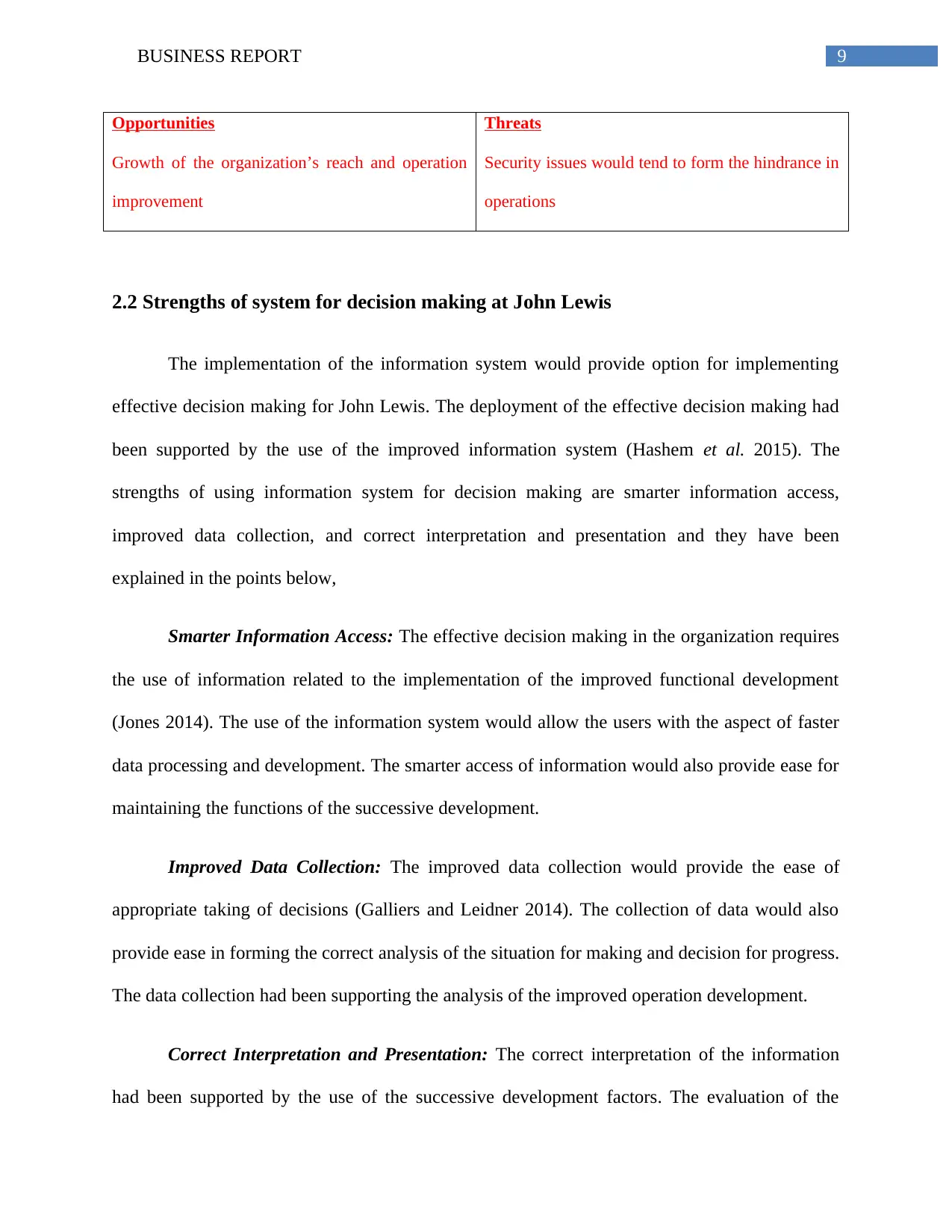
9BUSINESS REPORT
Opportunities
Growth of the organization’s reach and operation
improvement
Threats
Security issues would tend to form the hindrance in
operations
2.2 Strengths of system for decision making at John Lewis
The implementation of the information system would provide option for implementing
effective decision making for John Lewis. The deployment of the effective decision making had
been supported by the use of the improved information system (Hashem et al. 2015). The
strengths of using information system for decision making are smarter information access,
improved data collection, and correct interpretation and presentation and they have been
explained in the points below,
Smarter Information Access: The effective decision making in the organization requires
the use of information related to the implementation of the improved functional development
(Jones 2014). The use of the information system would allow the users with the aspect of faster
data processing and development. The smarter access of information would also provide ease for
maintaining the functions of the successive development.
Improved Data Collection: The improved data collection would provide the ease of
appropriate taking of decisions (Galliers and Leidner 2014). The collection of data would also
provide ease in forming the correct analysis of the situation for making and decision for progress.
The data collection had been supporting the analysis of the improved operation development.
Correct Interpretation and Presentation: The correct interpretation of the information
had been supported by the use of the successive development factors. The evaluation of the
Opportunities
Growth of the organization’s reach and operation
improvement
Threats
Security issues would tend to form the hindrance in
operations
2.2 Strengths of system for decision making at John Lewis
The implementation of the information system would provide option for implementing
effective decision making for John Lewis. The deployment of the effective decision making had
been supported by the use of the improved information system (Hashem et al. 2015). The
strengths of using information system for decision making are smarter information access,
improved data collection, and correct interpretation and presentation and they have been
explained in the points below,
Smarter Information Access: The effective decision making in the organization requires
the use of information related to the implementation of the improved functional development
(Jones 2014). The use of the information system would allow the users with the aspect of faster
data processing and development. The smarter access of information would also provide ease for
maintaining the functions of the successive development.
Improved Data Collection: The improved data collection would provide the ease of
appropriate taking of decisions (Galliers and Leidner 2014). The collection of data would also
provide ease in forming the correct analysis of the situation for making and decision for progress.
The data collection had been supporting the analysis of the improved operation development.
Correct Interpretation and Presentation: The correct interpretation of the information
had been supported by the use of the successive development factors. The evaluation of the
Paraphrase This Document
Need a fresh take? Get an instant paraphrase of this document with our AI Paraphraser
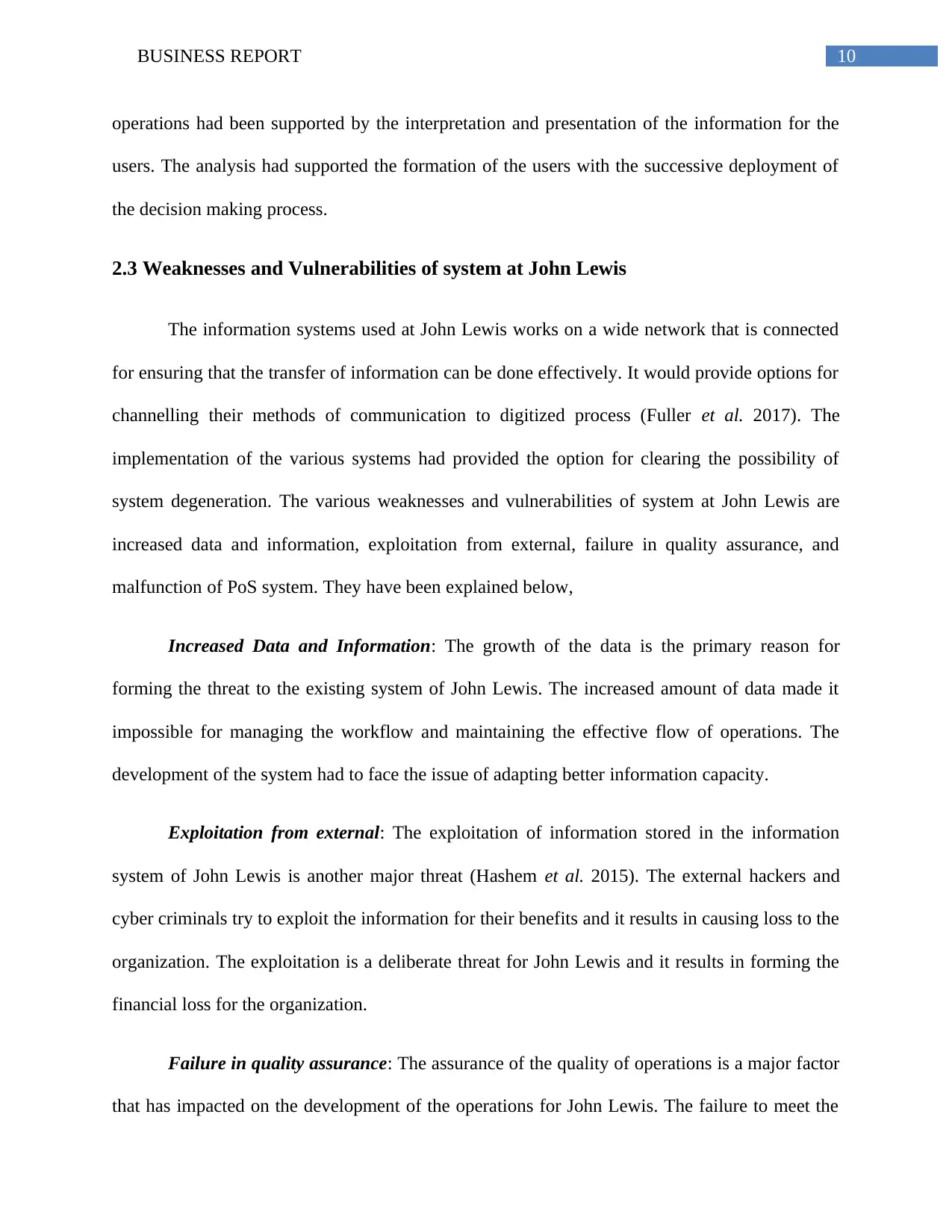
10BUSINESS REPORT
operations had been supported by the interpretation and presentation of the information for the
users. The analysis had supported the formation of the users with the successive deployment of
the decision making process.
2.3 Weaknesses and Vulnerabilities of system at John Lewis
The information systems used at John Lewis works on a wide network that is connected
for ensuring that the transfer of information can be done effectively. It would provide options for
channelling their methods of communication to digitized process (Fuller et al. 2017). The
implementation of the various systems had provided the option for clearing the possibility of
system degeneration. The various weaknesses and vulnerabilities of system at John Lewis are
increased data and information, exploitation from external, failure in quality assurance, and
malfunction of PoS system. They have been explained below,
Increased Data and Information: The growth of the data is the primary reason for
forming the threat to the existing system of John Lewis. The increased amount of data made it
impossible for managing the workflow and maintaining the effective flow of operations. The
development of the system had to face the issue of adapting better information capacity.
Exploitation from external: The exploitation of information stored in the information
system of John Lewis is another major threat (Hashem et al. 2015). The external hackers and
cyber criminals try to exploit the information for their benefits and it results in causing loss to the
organization. The exploitation is a deliberate threat for John Lewis and it results in forming the
financial loss for the organization.
Failure in quality assurance: The assurance of the quality of operations is a major factor
that has impacted on the development of the operations for John Lewis. The failure to meet the
operations had been supported by the interpretation and presentation of the information for the
users. The analysis had supported the formation of the users with the successive deployment of
the decision making process.
2.3 Weaknesses and Vulnerabilities of system at John Lewis
The information systems used at John Lewis works on a wide network that is connected
for ensuring that the transfer of information can be done effectively. It would provide options for
channelling their methods of communication to digitized process (Fuller et al. 2017). The
implementation of the various systems had provided the option for clearing the possibility of
system degeneration. The various weaknesses and vulnerabilities of system at John Lewis are
increased data and information, exploitation from external, failure in quality assurance, and
malfunction of PoS system. They have been explained below,
Increased Data and Information: The growth of the data is the primary reason for
forming the threat to the existing system of John Lewis. The increased amount of data made it
impossible for managing the workflow and maintaining the effective flow of operations. The
development of the system had to face the issue of adapting better information capacity.
Exploitation from external: The exploitation of information stored in the information
system of John Lewis is another major threat (Hashem et al. 2015). The external hackers and
cyber criminals try to exploit the information for their benefits and it results in causing loss to the
organization. The exploitation is a deliberate threat for John Lewis and it results in forming the
financial loss for the organization.
Failure in quality assurance: The assurance of the quality of operations is a major factor
that has impacted on the development of the operations for John Lewis. The failure to meet the
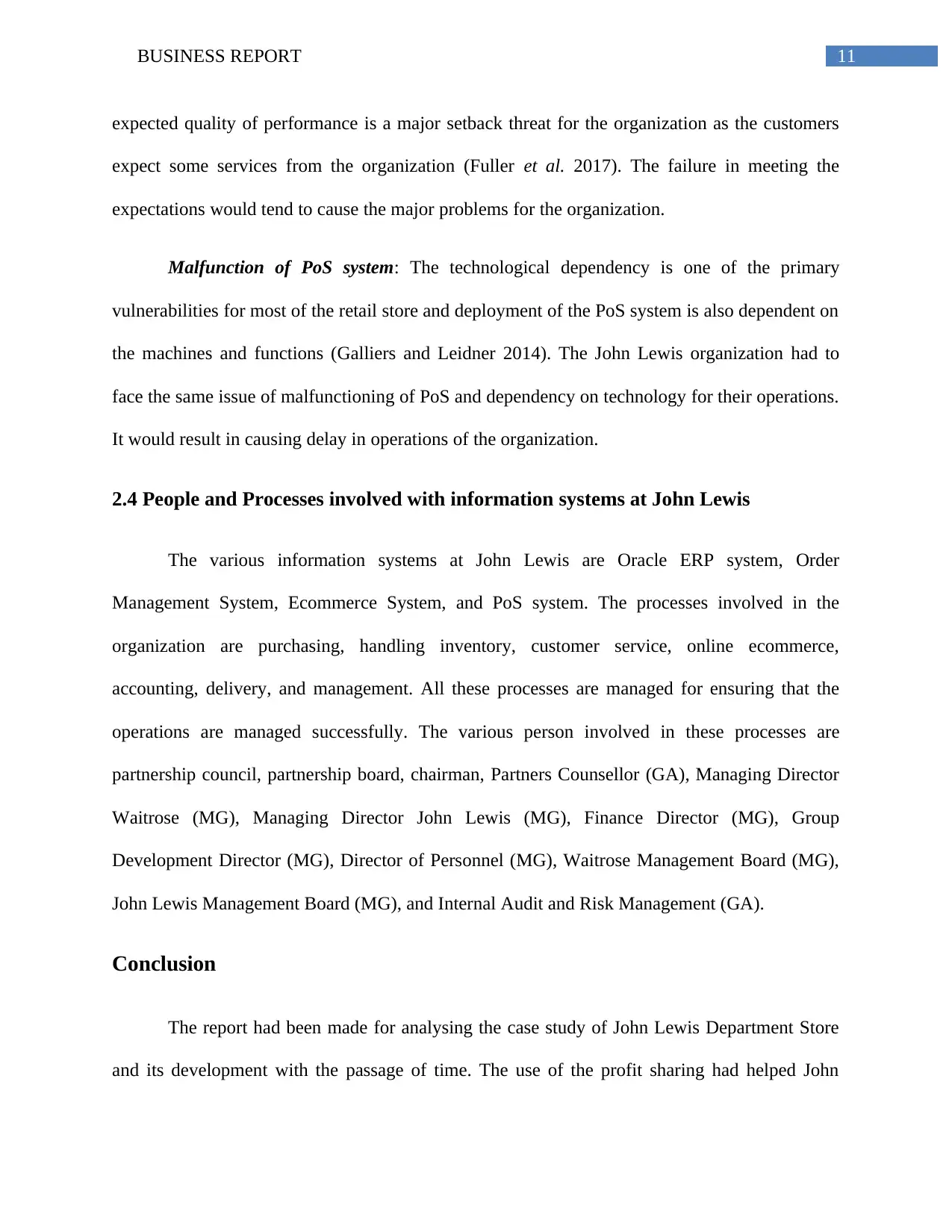
11BUSINESS REPORT
expected quality of performance is a major setback threat for the organization as the customers
expect some services from the organization (Fuller et al. 2017). The failure in meeting the
expectations would tend to cause the major problems for the organization.
Malfunction of PoS system: The technological dependency is one of the primary
vulnerabilities for most of the retail store and deployment of the PoS system is also dependent on
the machines and functions (Galliers and Leidner 2014). The John Lewis organization had to
face the same issue of malfunctioning of PoS and dependency on technology for their operations.
It would result in causing delay in operations of the organization.
2.4 People and Processes involved with information systems at John Lewis
The various information systems at John Lewis are Oracle ERP system, Order
Management System, Ecommerce System, and PoS system. The processes involved in the
organization are purchasing, handling inventory, customer service, online ecommerce,
accounting, delivery, and management. All these processes are managed for ensuring that the
operations are managed successfully. The various person involved in these processes are
partnership council, partnership board, chairman, Partners Counsellor (GA), Managing Director
Waitrose (MG), Managing Director John Lewis (MG), Finance Director (MG), Group
Development Director (MG), Director of Personnel (MG), Waitrose Management Board (MG),
John Lewis Management Board (MG), and Internal Audit and Risk Management (GA).
Conclusion
The report had been made for analysing the case study of John Lewis Department Store
and its development with the passage of time. The use of the profit sharing had helped John
expected quality of performance is a major setback threat for the organization as the customers
expect some services from the organization (Fuller et al. 2017). The failure in meeting the
expectations would tend to cause the major problems for the organization.
Malfunction of PoS system: The technological dependency is one of the primary
vulnerabilities for most of the retail store and deployment of the PoS system is also dependent on
the machines and functions (Galliers and Leidner 2014). The John Lewis organization had to
face the same issue of malfunctioning of PoS and dependency on technology for their operations.
It would result in causing delay in operations of the organization.
2.4 People and Processes involved with information systems at John Lewis
The various information systems at John Lewis are Oracle ERP system, Order
Management System, Ecommerce System, and PoS system. The processes involved in the
organization are purchasing, handling inventory, customer service, online ecommerce,
accounting, delivery, and management. All these processes are managed for ensuring that the
operations are managed successfully. The various person involved in these processes are
partnership council, partnership board, chairman, Partners Counsellor (GA), Managing Director
Waitrose (MG), Managing Director John Lewis (MG), Finance Director (MG), Group
Development Director (MG), Director of Personnel (MG), Waitrose Management Board (MG),
John Lewis Management Board (MG), and Internal Audit and Risk Management (GA).
Conclusion
The report had been made for analysing the case study of John Lewis Department Store
and its development with the passage of time. The use of the profit sharing had helped John
⊘ This is a preview!⊘
Do you want full access?
Subscribe today to unlock all pages.

Trusted by 1+ million students worldwide
1 out of 17
Related Documents
Your All-in-One AI-Powered Toolkit for Academic Success.
+13062052269
info@desklib.com
Available 24*7 on WhatsApp / Email
![[object Object]](/_next/static/media/star-bottom.7253800d.svg)
Unlock your academic potential
Copyright © 2020–2025 A2Z Services. All Rights Reserved. Developed and managed by ZUCOL.





